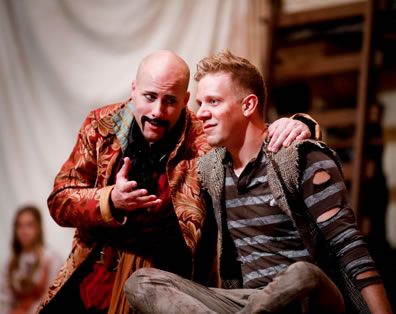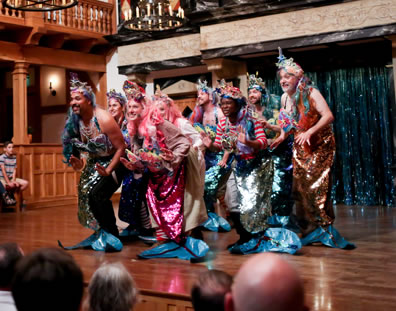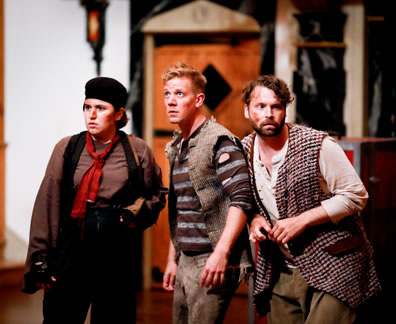Peter and the Starcatcher
Such Starstuff As Dreams Are Made On
By Rick Elice, Music by Wayne Barker, Based on the novel by Dave Barry and Ridley Pearson
American Shakespeare Center, Blackfriars Playhouse, Staunton, Virginia
Saturday, September 23, 2017, C–5&6 (center stalls)
Directed by Jim Warren
Something significant is missing in the American Shakespeare Center's production of Rick Elice's Peter and the Starcatcher at the Blackfriars Playhouse in Staunton, Virginia.

Black Stache (Greg Brostrom, left) confers with Peter (Benjamin Reed) in the American Shakespere Center's production of Rick Elice's Peter and the Starcatcher at the Blackfriars Playhouse. In the background, Lauren Ballard, who plays Molly, watches. Photo by LIndsey Walters, American Shakespeare Center.
Good acting? That's here: This company is up to the high standards of comic and dramatic talent we've come to expect with the American Shakespeare Center (ASC). Competent directing? Jim Warren, company co-founder and until this year its artistic director, is as sure-handed in this space as they come, and that experience is on display with this play. The skills needed to perform the play's music by Wayne Barker? This is the ASC; when it comes to musical performances, these guys are rock stars. High-tech special effects? That's always missing in a production at the Blackfriars Playhouse, the world's only re-creation of William Shakespeare's own indoor theater. Plays here use the same production conditions Jacobean theater used, sans electronics, digital technology, and sets other than props and costumes.
Ah, that's what's missing: Shakespeare, right? Elice's script is based on the novel by Dave Barry and Ridley Pearson, a prequel to J.M. Barrie's classic tale of Peter Pan. But, no, that's not the answer, for I count only three degrees of separation between this Peter and the Starcatcher and the company's namesake playwright, and this play in itself is distinctly Shakespearean in one particular element—which leads us to the significant thing missing in this production.
A wall. Any wall: fourth wall, third or second walls; there's not even a first wall because no backstage is truly necessary. Elice's play, which opened on Broadway in 2012, is so psychologically connected to the plays Shakespeare wrote 400 years ago that it represents how theater has come full circle back to Shakespeare's dynamic brand. This cast of actors in this space and a director well-versed in Shakespeare's original theatrical methodology demonstrate this key link with Peter and the Starcatcher, a play in which the audience is invited inside the theatrical process. On our imaginary forces it works, cribbing from Henry V here—though Peter and the Starcatcher opens with a line similar to that of Henry V's Chorus: "Supposing all these planks and ropes are now the British Empire…"
For the past several years, the ASC has been supplementing its Shakespearean/early modern classic fare with contemporary plays, often in tandem with a Shakespeare title (e.g., The Lion in Winter with King John in 2012). In 2013 the company produced Return to the Forbidden Planet, a Shakespearean/pop music mashup that stirred a desire in the company and its audience for more musicals. Last year came Bloody Bloody Andrew Jackson, its Shakespearean connection ostensibly being that it is a history play (or musical) of an American king (or president).
With Peter and the Starcatcher, ASC isn't fitting a contemporary play textually or contextually into the company's Shakespeare pedigree; rather, it's fitting it into the Blackfriars theatrical aesthete. Peter and the Starcatcher is “about imagination and community—the starstuff that permeates what the ASC has been doing for 29 years,” Warren writes in his program notes. “This ‘story theater' play is perfectly suited for the ASC, our use of Shakespeare's staging conditions, and Shakespeare's theater of imagination.”
Story theater is a style of staging in which a company of actors tells a story using simple props, enacting multiple characters, and providing the narration—essentially what Chorus intimates Shakespeare's company does in staging Henry V. ASC's production of Peter and the Starcatcher most resembles a bunch of kids staging a play in the backyard with makeshift props and costumes and playing multiple roles. Their theater is comprised almost entirely of their imaginations, and they expect their audience—mom and dad, neighbors, friends—to share in that imagination, creating a communal theater of imagination.
When Elice began working on the play's original staging, produced by Disney Theatrical Productions, his script ended up in the hands of a duo of directors: Roger Rees and Alex Timbers. The two directors embraced the style of story theater, Elice writes in the preface to his script, “In order to create a simple, stark environment in which to tell a young person's story in an adult, muscular, and surprising way. …The story theater style gave me the freedom to create a vast landscape of far-flung places, physical and emotional. And the wings to take you there.” Rees, notably, was a longtime member of the Royal Shakespeare Company, and the company used this style of staging in its landmark production of Charles Dickens' The Life and Adventures of Nicholas Nickleby with Rees in the title role.
Thus we have a play that starts in England and ends on Mollusk Island somewhere far away. There are ship chases, there are storms, there are talking fish, there are dancing mermaids, there are pirates, of course, and there is starstuff that can make you fly. But that's not the real magic of this staging—OK, the chorus line of singing mermaids is magical and hysterical, with surreal but practical (dancing with single fins?) costumes by Jenny McNee and choreography and movement by Stephanie Holladay Earl. For me as a man who digs the theatrical arts in all its many facets, the magic is in the simple craftsmanship of this staging. The actors play hallways and creaking doors, provide sound effects of a ship at sea, and use mime and ribbons to turn the stage (and the audience) into a roiling ocean with sea spray. Simple lighting effects create the glowing starstuff and a fairy dashing back and forth among the orphans. Molly Aster (Lauren Ballard) uses starstuff to elevate herself; and then Peter (Benjamin Reed) caps off the production by flying without aid of any mechanical contraption (he has aid, just not mechanical).
Along the way you get a script that provides edge-of-the-seat adventure with so many great jokes, puns, and plot-jumping connections I couldn't write them in my notes fast enough. Among those I captured:
- Molly's governess, Mrs. Bumbrake (Christopher Seiler), mentions her "salad days" in a house in Brighton, where the kitchen boy made a "cunning cannelloni, plus a pasta fazool to make you drool." Later, Fighting Prawn (Chris Johnston), king of the Mollusks on the mystery island, shouts "Pasta" as the signal for attack—and "Antipasta" as the signal to leave off the attack.
- “We are no ruffians. We've never even been to Ruffia."
- When Molly mentions starstuff, the treasure-seeking pirate, Black Stache (Greg Brostrom), replies, "Starbucks? What's Starbucks?"
- That treasure is, for Stache, as “elusive as a melody in a Philip Glass opera.”
- Stache fashions himself a poet, but "Which style to use? Iambic?" He glances at the audience as if sharing an elite secret, and then says, “Box office poison.” Nevertheless, he uses a famous line from a Shakespeare sonnet to win a poetic sword fight with the rival captain Slank (David Anthony Lewis). And speaking of (or in) Shakespeare,
- A treasure trunk filled with sand becomes a "treasure trunk sans treasure"—OK, maybe that's a joke only a writer or Jacques from As You Like It might appreciate. But speaking of that treasure trunk,
- When Stache accidently slams shut the trunk's lid on his hand, he turns to his first mate Smee (Allison Glenzer) for help, and Smee assures Stache that she's "your right-hand man." "Not anymore, Smee," Stache says.
- Stache reveals what's left of his arm, and asks Smee "what am I to do now?" "I'm stumped, sir," Smee replies.
- Of course, the big crocodile shows up, but debate arises over whether to throw it Stache's hand or just give it the finger.
- After all, Smee earlier pointed out, the big crocodile has been "chewing all the scenery, sir" (I'm not making this up, though I wish I had).
This is silly stuff—brilliantly so; after all, it has Dave Berry's pedigree. However, these actors have a pedigree of extensive experience with, and utmost respect for, the early modern classics of Shakespeare and his contemporaries. Thus, we've seen a lot of silly stuff—much of it in iambic—played out on the Blackfriars stage, written by Marlowe, Middleton, Fletcher, Jonson, Beaumont, Ford, and Shakespeare, too. ASC actors always sell it straight and make it all the more genuinely (and accessibly) funny by doing so. Such a company is a perfect fit for this silly stuff along with the play's magical starstuff.
This is such a great ensemble ride that it is unfair to point to single performances—except that, in one instance, we have no choice (even the cast grants this). I'll use that as a window to fly through to discuss a couple of performances that exemplify what makes the entire ensemble so right for this play. One of those is Reed as Peter, the 13-year-old orphan boy, abused his whole life and certain that all adults lie, who just wants to "be a boy for awhile." Reed brings muscular integrity to the role, very much a boy in stature and manners, but avoiding little boy tropes and pitiable behavior in the playing of it. His orphan companions are Prentiss (Allie Babich) and Ted (Josh Innerst) who also capture the bearings of wild-eyed childhood innocence to the point that you don't even notice that Ted has a well-groomed beard. Ted, obsessed with food, spends much of the latter part of the play trying to open a pineapple. When Fighting Prawn orders him to tell a story in one minute, Ted cries, "What am I supposed to do in one minute? I can't transform, I can't inhabit the character." As he speaks this line, Inneerst is staring at the pineapple in his hand as if it were Yorick's skull (Innerst is slated to play Hamlet on this stage beginning in January).


Top, the fetching mob of mermaids singing their song by Wayne Barker—"You're likely wondering what we've had to drink now, and you might think, 'Now they've gone too far,' but something we should not have been exposed to, we got too close to, by swimming aft, of Peter's raft, and here we are"—in the American Shakespeare Center's production of Rick Elice's Peter and the Starcatcher at the Blackfriars Playhouse. From left, René Thornton Jr., Allie Babich, Greg Brostrom (obscured), Allison Glenzer, Lauren Ballard, Tim Sailer, Shunté Lofton, Josh Innerst, and Christopher Seiler. Costumes by Jenny McNee. Above, the orphans explore Mollusk Island: from left, Prentiss (Allie Babich), Peter (Benjamin Reed), and Ted (Josh Innerst). Photos by Lindsey Walters, American Shakespeare Center.
The entire ensemble is good like that; but Black Stache is the unquestionable star vehicle of Peter and the Starcatcher. Christian Borle originated the role for the play's Broadway debut and rode it to his first Tony Award. He won his second Tony playing Will Shakespeare in Something Rotten! That's two degrees of separation between Shakespeare and this production; the third degree is in the impact of a character performance. On Shakespeareances.com I wrote of Something Rotten!, "Borle achieves something I've only experienced one other time in all the theater I've seen: a performance that is more than indelible—it possesses you" (the other was Anthony Hopkins as Le Roux in David Hare's Pravda at the National Theatre in London). Make that three times now with Brostrom's Black Stache. In his self-consciously theatrical movements, in his Snidely Whiplash glances and asides to the audience, in his excessive pretension, Brostrom does an over-the-top portrayal of a role that is written as over-the-top (the audience is instructed to cheer wildly whenever someone announces the name BLACK STACHE, always spoken in all-capital letters).
Yet, this is no mere hamming by an actor whom we also witnessed playing in three Shakespeare plays in this repertory: a sweetly genial King of Navarre in Love's Labour's Lost, a between-the-lines perfect Friar Frances as well as Borachio in Much Ado About Nothing, and countless characters in Henry VI, Part 3. In Peter and the Starcatcher, Brostrom establishes pinpoint comic timing with Glenzer's Smee, and he could do Stache's trunk-lid slamming scene as an audition to win any role he aspires to. "Omigod. Omigod. Omigod … Omigod," he says in dozens of repetitions, each "Omigod" spoken with a different inflection. Just when you think the joke has run its course, Brostrom takes it for another lap, then another, and we stay entranced, laughingly so, for the entire marathon of Omigods. I could make a top-ten list of soliloquies and speeches I've seen on this stage: nine of them would be by Shakespeare, and one would be "Omigod."
This is not silly stuff. This is Shakespearean. How many laps does Bottom run when he shouts "Die!" as his Pyramus expires in A Midsummer Night's Dream? What Bottom and his fellow Rude Mechanicals try to pull off as serious drama for Duke Theseus is not much different from the backyard theater of children. It's also not far removed from the primitive theatricality of Shakespeare's own company, all the while acknowledging to his audience that they are watching theater, and welcome into the show. Stache single-handedly concludes (yes, I stole that from the script) that gold is not the true treasure we should seek. "Time will be our treasure," he says, pointing out that his and Peter's story will be timeless, as are so many of the characters Shakespeare created for a bare stage.
Number four on my Top Ten Non-Shakespearean Theatrical Moments of 2016 was Fiasco Theater's production of Into the Woods, which I saw at the John F. Kennedy Memorial Center for the Performing Arts in Washington, D.C. I never got around to reviewing that production, but I loved how the New York-based company that achieved its initial fame by staging a ground-breaking Cymbeline with six actors and a trunk applied its small-cast, radical staging concepts to the Stephen Sondheim musical. With only an on-stage piano for accompaniment, simple props, and multiple doubling of roles (two men played the mean stepsisters by holding up dress frames in front of them), it was almost like watching a rehearsal. Yet, it certainly was a finished product with the talent on display and all the plot and thematic nuances of the play coming to the fore. In addition to seeing a bona fide Sondheim musical, we experienced the impression of theater being produced right before our eyes, the show inviting us into its own creative process and sharing in its intellectual evolution.
Peter and the Starcatcher at the Blackfriars catches that same spirit, which Shakespeare's original audiences also caught. It comes with the acknowledgment that this isn't supposed to be a movie or a video game or virtual reality or even theatrical illusion. This is theatrical reality with real human contact (literally: audience members become part of these shows). It transports us to an even more magical dimension: our imaginations.
Eric Minton
November 1, 2017
Comment: e-mail editorial@shakespeareances.com
Start a discussion in the Bardroom



 Find additional Shakespeareances
Find additional Shakespeareances